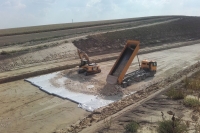A 5 Northern Motorway, Schrick - Poysbrunn Section
Client: Provincial Government of Lower Austria / ASFINAG (Motorway Financing AG)
Development Period: since 2004
The objective project is part of the A 5 Northern Motorway, which runs between the junction Eibesbrunn (S 1 Outer Ring Vienna Motorway) and Drasenhofen (State Border towards Brno). It comprises the new construction of a 25 km long Motorway section.
Within the project area, five interchanges and 45 bridges are situated. In the course of the earthworks, 6 mio. cubic metres of soil material have to be moved for the cuts and the embankments. Furthermore, extensive noise protection measures are implemented.
First of all, BGG Consult prepared the expert's reports in the fields of geology hydrogeology and geotechnics for the procedures of route selection and environmental impact assessment, by order of the Provincial Government of Lower Austria. The documents included the definition of measures regarding earthwork and recommendations regarding the foundation of the structures as well as statements concerning the impact of the construction on the groundwater and the definition of the remaining impact according to EIA Act.
For the detail project, BGG consult supervised and evaluated supplementary subsoil explorations by order of the ASFINAG. Based on these, geotechnical expert's reports were compiled for the different contract sections.
During construction, the earthworks and the special heavy construction works are supervised and a hydrogeological preservation of evidence is conducted.
Mass Balance Earthworks:
In order to minimize the impact on the environment and for economic reasons, it was planned at the objective construction to reuse all material excavated in the cut areas for embankments or landscape modelling. Since the excavations take place mostly within Loess or Miocene silt or sand, soil stability measures are often necessary in order to achieve a sufficient stability and serviceability of the motorway embankments. The details of the measures are defined individually for each fill layer, depending on the fill material and the weather conditions. Based on long standing experience and trial fields, the amount and composition of the binders are optimized.
October 2016
